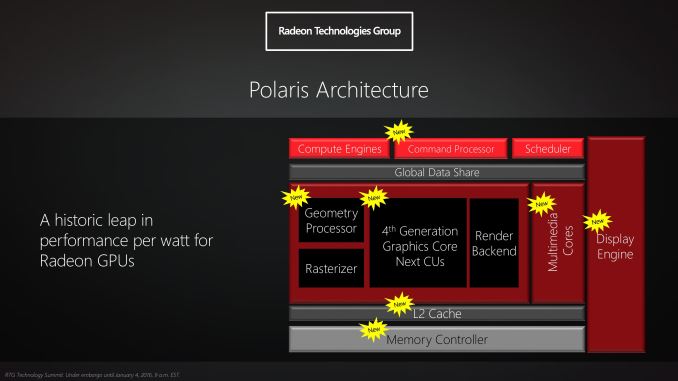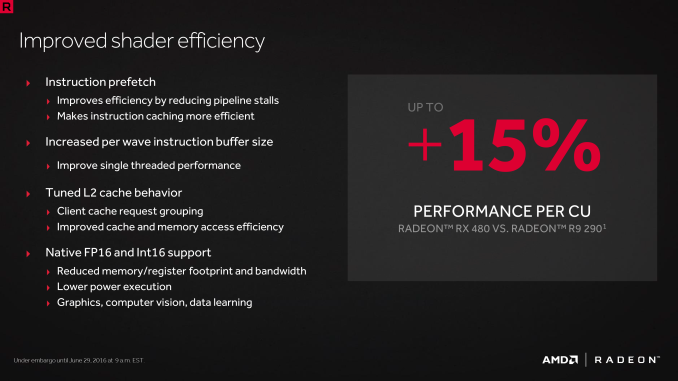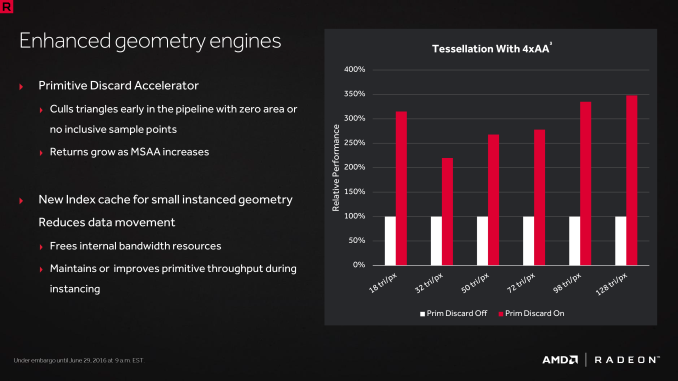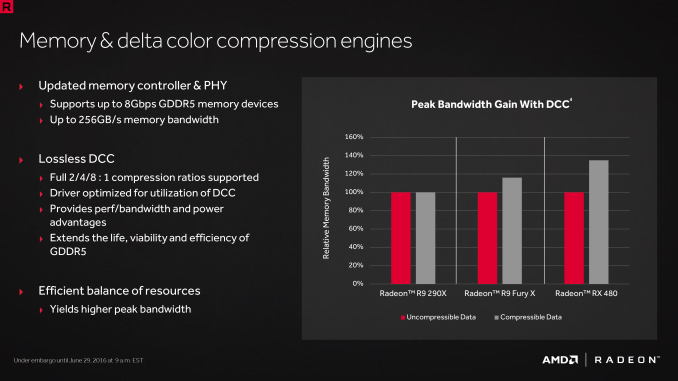The AMD Radeon RX 480 Preview: Polaris Makes Its Mainstream Mark
by Ryan Smith on June 29, 2016 9:00 AM ESTThe Polaris Architecture: In Brief
For today’s preview I’m going to quickly hit the highlights of the Polaris architecture.
In their announcement of the architecture this year, AMD laid out a basic overview of what components of the GPU would see major updates with Polaris. Polaris is not a complete overhaul of past AMD designs, but AMD has combined targeted performance upgrades with a chip-wide energy efficiency upgrade. As a result Polaris is a mix of old and new, and a lot more efficient in the process.
At its heart, Polaris is based on AMD’s 4th generation Graphics Core Next architecture (GCN 4). GCN 4 is not significantly different than GCN 1.2 (Tonga/Fiji), and in fact GCN 4’s ISA is identical to that of GCN 1.2’s. So everything we see here today comes not from broad, architectural changes, but from low-level microarchitectural changes that improve how instructions execute under the hood.
Overall AMD is claiming that GCN 4 (via RX 480) offers a 15% improvement in shader efficiency over GCN 1.1 (R9 290). This comes from two changes; instruction prefetching and a larger instruction buffer. In the case of the former, GCN 4 can, with the driver’s assistance, attempt to pre-fetch future instructions, something GCN 1.x could not do. When done correctly, this reduces/eliminates the need for a wave to stall to wait on an instruction fetch, keeping the CU fed and active more often. Meanwhile the per-wave instruction buffer (which is separate from the register file) has been increased from 12 DWORDs to 16 DWORDs, allowing more instructions to be buffered and, according to AMD, improving single-threaded performance.
Outside of the shader cores themselves, AMD has also made enhancements to the graphics front-end for Polaris. AMD’s latest architecture integrates what AMD calls a Primative Discard Accelerator. True to its name, the job of the discard accelerator is to remove (cull) triangles that are too small to be used, and to do so early enough in the rendering pipeline that the rest of the GPU is spared from having to deal with these unnecessary triangles. Degenerate triangles are culled before they even hit the vertex shader, while small triangles culled a bit later, after the vertex shader but before they hit the rasterizer. There’s no visual quality impact to this (only triangles that can’t be seen/rendered are culled), and as claimed by AMD, the benefits of the discard accelerator increase with MSAA levels, as MSAA otherwise exacerbates the small triangle problem.
Along these lines, Polaris also implements a new index cache, again meant to improve geometry performance. The index cache is designed specifically to accelerate geometry instancing performance, allowing small instanced geometry to stay close by in the cache, avoiding the power and bandwidth costs of shuffling this data around to other caches and VRAM.
Finally, at the back-end of the GPU, the ROP/L2/Memory controller partitions have also received their own updates. Chief among these is that Polaris implements the next generation of AMD’s delta color compression technology, which uses pattern matching to reduce the size and resulting memory bandwidth needs of frame buffers and render targets. As a result of this compression, color compression results in a de facto increase in available memory bandwidth and decrease in power consumption, at least so long as buffer is compressible. With Polaris, AMD supports a larger pattern library to better compress more buffers more often, improving on GCN 1.2 color compression by around 17%.
Otherwise we’ve already covered the increased L2 cache size, which is now at 2MB. Paired with this is AMD’s latest generation memory controller, which can now officially go to 8Gbps, and even a bit more than that when oveclocking.














449 Comments
View All Comments
Peichen - Wednesday, June 29, 2016 - link
Feel like AMD finally caught up with i5-2500K in price, performance and power but the game already moved on a long time ago. That's how AMD's CPU division died isn't it? Always a step or two behind.14nm card with the performance and power of a 2-years old 28nm card. If Nvidia is lazy, a die shrink 970 on 14nm will match 480 and be cheaper to make. The new 1060 will probably be even cheaper for Nvidia to make to maintain profitability.
I am glad there are people still firmly in the AMD camp. I moved to Nvidia over a year ago but we always need someone to make sure Nvidia's mainstream pricing is not over-the-top.
Nickgofly2019 - Wednesday, June 29, 2016 - link
Lmfao this is amazingly disappointing. I had the feeling when they said "VR ready" that it was just going to be around 970 performance, what Nvidia called "VR ready". Newsflash people: 970s have been selling for $260-$300 for about a year now. This "generational" leap from AMD to 16nn was only able to get them to that level of performance and the power consumption of a generation old Nvidia 28nn process that's been selling for <300. Nvidia at this point could just ask sellers to drop their 970 prices to 200 until the 1060/1050 come out and boom they'd be "competing" with this shitty, loud, power hungry for the process card. Nothing's changed, AMD is still largely behind in all aspects, got t hopes up too fast. I suspect the 1060 at $300 will have 980 performance and the 1050 compete with this at $200.DonMiguel85 - Wednesday, June 29, 2016 - link
Chances are the 1060 will be more or less a 1080 chopped in half with a 192-bit bus, so unless they price it at $250 or less I think the RX 480 will still be a much better buy.AntDX316 - Thursday, June 30, 2016 - link
There is some law of why NVidia cannot totally shut out AMD. There was news about a problem with Intel and AMD way way back and AMD was fined or sued for like $1.1B. It was some monopoly agreement or something.fanofanand - Thursday, June 30, 2016 - link
You have it back asswards. Intel was fined for their anti-competitive monopolistic policies.DonMiguel85 - Wednesday, June 29, 2016 - link
GTX 1060 is rumored to come in only 3GB and 6GB flavors with a 192-bit bus and 1280 shaders. Even if it can overclock to around ~2GHz performance will likely be between the 970 and 980. I think this card is still a better buy for the extra 2GB VRAM. Just consumes more power.none12345 - Wednesday, June 29, 2016 - link
I was hoping for a lil bit more performance, but all in all this card beats anything else in its price range by a large margin. I was expecting it to be a bit slower then a 980, but instead its a bit faster then a 970(that bit should grow to a good bit faster in the games just about to be released, or released in the next year, and it probably will be more or less a 980 in those games). If i had $200 to spend, and the 970 dropped another $80 to $200, id still get a 4gb 480 over the 970. But as of today the 970s price is way too high to even be a consideration against the 480.If i didnt get a graphics card in december, id be buying a 480 the second one of the manufactures releases one with an open air cooler and an 8pin power connector(i would wait and not buy the reference, but im patient).
To those complaining that a 480 is only a bit faster then the 970 that released 2 years ago. Well DUH, but then you are comparing a $330 card to a $240 card or a $330 card to a $200 card. The 970 prices are falling like a rock because of the new cards coming out. It will continue to fall in price untill its price/pef matches what is coming out, but again DUH, thats how the market works.... As of right now, checking newegg, the 970 is way too high of a price to even be considered a contender.
KoolAidMan1 - Wednesday, June 29, 2016 - link
One problem is that you really want to spend more on the 8GB model in order to really compete with the GTX 970. Getting comparable performance the the 970 for $200 is great, except that's not what's actually happening.I'm very curious to see what the price and performance on the 1060 end up being.
Teknobug - Wednesday, June 29, 2016 - link
Amazong, a review on an unreleaesd RX 480 over a month old GTX1080?Hrel - Wednesday, June 29, 2016 - link
Looks like AMD has just become the hardware you buy because you literally can't afford something better.I cannot imagine even one scenario in which I wouldn't use Intel and Nvidia to build a computer, hence forth.